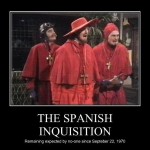Does the Bible Affirm the Existence of Mythical Creatures?
by Trent Horn
Filed under The Bible
One common argument against the inspiration or even the trustworthiness of the Bible is that it affirms the existence of mythical creatures. For example, atheist Jason Long says, “The cockatrice, unicorn, and dragon, are examples of mythical creatures in the Bible that fail to leave any reliable evidence for their existence.”1
Do these legendary animals prove the Bible itself is a collection of legends? No, because in most cases the Bible is affirming the existence of real animals. It is only the work of later translators, and not the Bible’s original authors, that refer to these legendary creatures. This is especially prevalent in the King James Version of the Bible (or the KJV) which became popular for skeptics to quote ever since Steve Wells used this translation for his popular Skeptics Annotated Bible.
In this post I’ll examine two animals in the KJV that critics often cite: the unicorn and the cockatrice.
Unicorns
A unicorn is a horse with a long horn that protrudes from its forehead that medieval literature described as possessing medicinal or even magical powers. In the KJV the unicorn is depicted as a symbol of strength and wild power. Numbers 23:22 says, “God brought [the Israelites] out of Egypt; he hath as it were the strength of an unicorn.” In Job 39:9-10 God points out Job’s human limits and says, “Will the unicorn be willing to serve thee, or abide by thy crib? Canst thou bind the unicorn with his band in the furrow?”
The Hebrew word the KJV translates as “unicorn” is re’em, which modern scholars have identified with an auroch, or a large horned cow that is now extinct. The ancient Assyrians also referred to these animals by the similar name rimu.2 So how did the Hebrew word re’em become “unicorn” in translations like the KJV?
The translators of the Septuagint, or the ancient Greek translation of the Old Testament, used the Greek word monoceros (literally “one-horn”) in place of the Hebrew word re’em. In the fifth century St. Jerome translated the Septuagint into the Latin Vulgate and used the Latin equivalent of “monoceros,” or “unicorn.” Eventually, this word became “unicorn” in English.
But why did the Septuagint translators use a word that literally meant “one horn” instead of something like “wild ox? One theory is that the Septuagint translators may have been thinking of another animal besides a wild ox that also fits the description found in passages like Numbers 23:22. The first century Roman naturalist Pliny the Elder described a real animal from India called a monoceros that,
“has the head of the stag, the feet of the elephant, and the tail of the boar, while the rest of the body is like that of the horse; it makes a deep lowing noise, and has a single black horn, which projects from the middle of its forehead, two cubits in length. This animal, it is said, cannot be taken alive.”3
Today, in northern India, there is a very strong animal with feet like an elephant, a large body, and one horn that protrudes from its head. If we allow some leeway in Pliny’s description (which is necessary in ancient descriptions of unique creatures) we can identify this creature with the modern Indian rhinoceros. Indeed, monoceros means in Greek “one horn” and rhinoceros means “nose horn” (or rino ceros). A rhinoceros would make sense of these passages because, unlike unicorns, they are known for being very strong beasts that can’t be domesticated.
Even though a rhinoceros would fit the sense of these passages, in order to remain faithful to the original language, and to avoid confusion with the medieval conception of a unicorn, most modern translations of the Bible render the Hebrew word in these passages as, “wild ox” and not “unicorn” or “one-horn.”
The Cockatrice
This creature is mentioned several times in the KJV’s translations of the books of the prophets. Jeremiah 8:17 reads, “For, behold, I will send serpents, cockatrices, among you, which will not be charmed, and they shall bite you, saith the Lord.” Isaiah 11:8 says, “And the sucking child shall play on the hole of the asp, and the weaned child shall put his hand on the cockatrice' den.” Long says of this creature, “The prophet Isaiah informs us that a cockatrice, a mythical creature able to kill it’s victim with a casual glance, will arise from a serpent (Isa. 14:29). What tangible evidence do we have to believe that a creature with this incredible ability has ever existed?”4
But Long is mistaken in his description because Isaiah never mentions the “cockatrice” nor does he describe this creature as having supernatural powers. Like the King James Bible in whose pages it is found, the cockatrice is a product of medieval European thinking and would have been unknown to prophets like Jeremiah or Isaiah. According to English scholar Laurence Breiener, “The cockatrice, which no one ever saw, was born by accident toward the end of the twelfth century and died in the middle of the seventeenth.”5
Although allusions to the creature can be traced back to Pliny the Elder, the dissident Catholic John Wycliffe first used the term “cockatrice” in 1382 in his popular translation of the Bible. It was later used in the 1535 Coverdale Bible, which may have been the source for the KJV’s use of this word.
While Isaiah and Jeremiah would have been unaware of the “cockatrice,” they would have known what a tsepha‘ was. This is the original Hebrew word used in passages like Isaiah 11:8 and it simply means “snake” or “viper.”6 Today, most modern translations render passages like Isaiah 11:8 in this way, “the weaned child shall put his hand on the adder’s den [an adder is a kind of venomous snake].”
Check the Original
Remember that the Bible was not written in 17th century English. It was written in ancient Hebrew (along with some Aramaic and Greek) for the Old Testament and ancient Greek for the New Testament (the Old Testament was later translated into the Greek Septuagint). This refutes objections raised by atheists like David Mills, who says of passages that seem to describe mythical animals, “in the newer, modern-language translations of the Bible, these ridiculous passages of Scripture have been dishonestly excised, rewritten or edited beyond recognition from their original translation in the King James.”7
However, Mills is erroneously treating the KJV as if it were the original text of the Bible. The truth is that newer translations of the Bible are better than the KJV because they use earlier manuscripts that better capture the sense of the Bible’s original text. But even these bibles represent the opinions of modern translators. This is why when we confront a scripture passage that is difficult we must examine what the inspired author originally said in Hebrew or Greek. By doing this we sometimes see that the words the original word author used make more sense than what a later translator used instead, especially if the translation is an older one like the KJV.
Excerpted and adapted from Trent's upcoming book These are Hard Sayings: A Catholic Approach to Bible Difficulties (2016).
Related Posts
Notes:
- Jason Long. Biblical Nonsense: A Review of the Bible for Doubting Christians (iUniverse, 2005) 159 ↩
- G. Johannes Botterweck and Helmer Ringgren, Theological Dictionary of the Old Testament, Vol. 13 (Grand Rapids: Wm. B. Eerdmans Publishing, 2004) 243. ↩
- Pliny the Elder. Natural History. 8.31 ↩
- Long, 159 ↩
- Laurence Breiner. “The Career of the Cockatrice” Isis Vol. 70 No. 1 (1979) 30. ↩
- See Strong’s Concordance 6848 ↩
- David Mills. Atheist Universe (Berkeley: Ulysses Press, 2006) 150. ↩
Note: Our goal is to cultivate serious and respectful dialogue. While it's OK to disagree—even encouraged!—any snarky, offensive, or off-topic comments will be deleted. Before commenting please read the Commenting Rules and Tips. If you're having trouble commenting, read the Commenting Instructions.













